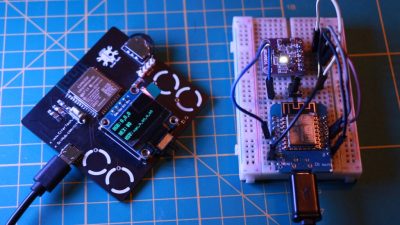Have you ever wanted to match paint to the color of a pillow, or make a website where the primary color matches your favorite shade of electrolytic capacitor? Then ColorReplica is the project for you.
 At the heart of this build are two ESP32s, one of which controls the color picker, and the other lights up the 18 WS2812 LEDs and displays information on the OLED screen.
At the heart of this build are two ESP32s, one of which controls the color picker, and the other lights up the 18 WS2812 LEDs and displays information on the OLED screen.
ColorReplica has two modes, ColorPicker and ColorCube. In ColorPicker mode, you just choose what color you want, adjust the brightness level, and choose between static and dynamic modes for the LEDs. [CiferTech] used the ESP32 touch pins extended to pads on the PCB to control different menu variables, which is a nice touch.
In ColorCube mode, there’s a secondary circuit with a color sensor an another ESP32. Once detected, it transmits the color data to the main device at the push of a button. The RGB LEDs turn that color, and shows the RGB, HEX, and HSV values on the OLED screen. If you’d like to make one of these yourself, everything is available on GitHub.
Want something a big more tangible? Check out this color picker that types HEX codes for you.
















I tried to create something similar back in the day. It did -not- work out.
In fact, I think it was even used for a Hackaday “Fail Friday”.
https://saccade.com/writing/projects/ColorMeter/
When I click on the link “everything is available on GitHub”, i get a github project with some code. That’s great, but that’s far from being “everything”. Nothing about the hardware.
what if I want the color to be a nice dark brown
brown is just dark orange
Yep. Define *brown*.
The colours from the ws2812 are likely to be a long way from the sensor’s measurements. The colours aren’t even consistent.
So do you ‘close the loop’ and sense the colour from the leds, adjusting until they give the same sensor result ?
What if using an ESP32-CAM as the only device, to pick the colar and to drive the LEDs?
How well does it detect and reproduce Black 4.0?
Power switch will enable black 4.0 just turn it off and presto, black. works best if you’re in a dark room as well
Just reverse bias the LEDs so they absorb the ambient light.
Does anyone know how the component that he’s using to navigate the menu is called?
Navigation switch, thumbwheel switch?
https://www.digikey.com/short/znb205q3
With RGB led’s, how is it at reproducing light pastel colours?
I’d be interested to see the colour accuracy and gamut of the device. Stick it infront of a colorimeter like an i1display pro or similar for a simple test.
There’s quite a bit of stuff to consider to get a wide and accurate gamut.
Mikeselectricstuff on youtube goes into it quite well in some detail.
Came here for a comment like this. Phillips Hue originally (can’t use the justification with mass production this far down the line) to color match each other perfectly. WS2812’s are not known for their color accuracy. They’re known for being cheap, addressable, and having software to use them being accessible. So I suspect if you use the RBG values from this down at the big box store, you could be disappointed….depending on how closely you wanted the color to match what the device produced!
Brown has already been discussed, as well as the color gamut…so these issues aside, seems like many hackers stayed away from this for various reasons. Then again, there is the joke about the mathematician vs the engineer each told they can close 1/2 the distance to a goal in any one move. The mathematician walks out, while the engineer takes a few 1/2 distance closings, then says “Close enough” and takes the goal. Perhaps this is a situation where most of us are being the mathematician. Try it and find out. Personally, I’m not too artistic. Bare white walls with nothing on them (except maybe a few command strip hung single board computers) are fine with me, so I will not be testing the theory, or the device :)
Confused as to why each ws2812 has what seems like their own series resistor. The resistor is only necessary for the first led as protection against voltage swings to the data pin from long wire inductance (and that being said in this case there is no long wire as everything is on the same board so it’s arguable even the first led’s resistor can be omitted).